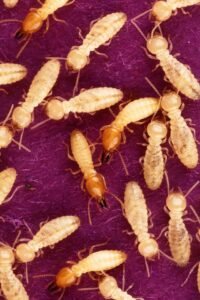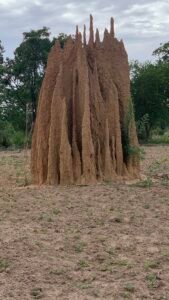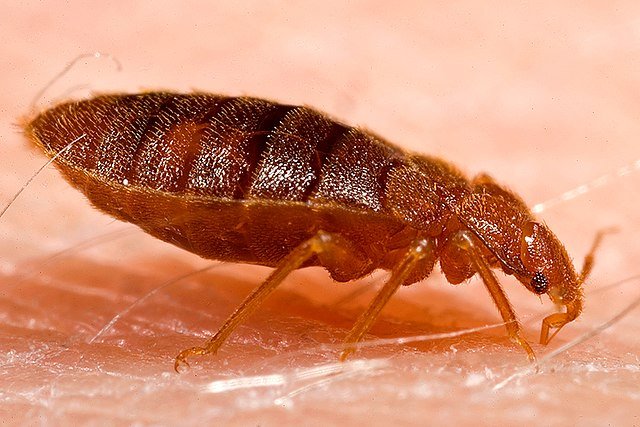Drywood Termites: Identification, Risks, and Complete Control Guide
 Drywood termites (Cryptotermes spp., Incisitermes spp.) are among the most destructive structural pests in warm and coastal regions. Unlike subterranean termites (Reticulitermes spp.), which require soil contact and high moisture, drywood termites live entirely within dry wood. This makes them harder to detect and more difficult to eliminate once they establish colonies.
Drywood termites (Cryptotermes spp., Incisitermes spp.) are among the most destructive structural pests in warm and coastal regions. Unlike subterranean termites (Reticulitermes spp.), which require soil contact and high moisture, drywood termites live entirely within dry wood. This makes them harder to detect and more difficult to eliminate once they establish colonies.
Because they do not need soil, drywood termites can infest furniture, flooring, window frames, and even structural timbers. Their silent feeding habits often go unnoticed until significant damage has occurred. This article explores their identification, biology, risks, and modern approaches to control.
Identification
Drywood termites differ from other termite species in several ways:
Color and Size: Workers are pale, cream-colored, and about 3–4 mm long. Soldiers are slightly larger with dark, strong mandibles. Winged reproductives (alates) are brown with smoky-gray wings that shed after mating flights.
No soil contact: They live exclusively in wood, requiring no connection to soil or external moisture.
Frass (termite pellets): Their most recognizable sign. These are six-sided, hard fecal pellets that resemble sawdust or coffee grounds, often found in small piles near exit holes.
Kick-out holes: Small holes in wood where pellets are pushed out by workers.
Infested wood: Sounds hollow when tapped and may show blistered or cracked surfaces.
By contrast, subterranean termites leave mud tubes and dampwood termites need moist, decaying wood. Drywood termites thrive in dry, sound timber.
Biology and Ecology
Drywood termites have unique adaptations:
Colonies: Small compared to subterranean termites, with 2,000–5,000 individuals.
Location: Colonies form entirely inside wood, from beams to picture frames.
Reproduction: Alates swarm during warm evenings, often after rain. Once they find a wood crevice, they seal themselves in and begin a new colony.
Diet: Cellulose in wood, paper, and other plant-based materials. They rely on symbiotic protozoa in their guts to break down cellulose.
Lifespan: Colonies grow slowly but persist for years, causing gradual structural weakening.
Their ability to survive without soil or high humidity allows them to infest dry indoor environments, a major reason they are a global threat.
Global Distribution
 Drywood termites occur in tropical and subtropical zones worldwide:
Drywood termites occur in tropical and subtropical zones worldwide:
United States: Primarily in the Southeast, Southwest, California, and Hawaii.
South America: Coastal regions with warm, humid climates.
Africa: Found in both tropical forests and dry savannas.
Asia and Australia: Common in urban and coastal areas.
Europe: Limited presence, often introduced through imported wood or furniture.
Shipping and trade in infested wood products have spread them globally, making them a problem even in non-native regions.
Risks and Damage
Drywood termites present unique risks:
Structural damage: Gradual weakening of beams, floors, and wooden furniture.
Hidden infestations: Damage often remains unnoticed until wood breaks or sounds hollow.
Economic cost: Billions of dollars annually in control and repairs, especially in the U.S.
Secondary risks: Infestations reduce property value and complicate real estate transactions.
Furniture damage: Antique and high-value furniture can be destroyed.
Unlike carpenter ants (Camponotus spp.), which excavate wood but don’t eat it, drywood termites consume cellulose, making damage permanent and extensive.
Signs of Infestation
Key signs include:
Frass pellets in piles near baseboards, windowsills, or furniture.
Kick-out holes along the surface of wooden structures.
Blistered wood surfaces that resemble water damage.
Hollow sound when wood is tapped.
Discarded wings after swarming events.
Structural weakness such as sagging floors or cracked beams.
Early detection of these signs is critical to avoiding costly repairs.
Control Methods
Because colonies live entirely within wood, treatment is challenging. Control strategies include:
Inspection: Professional termite inspections with moisture meters, sound detection, and borescopes.
Spot treatments: Drilling and injecting termiticides or foams directly into infested wood.
Whole-structure fumigation: Tent fumigation with sulfuryl fluoride or methyl bromide (where permitted). This eliminates all termites inside the building.
Wood replacement: Removing and replacing heavily damaged or infested wood.
Heat treatments: Heating infested areas to lethal temperatures.
Preventive treatments: Applying borate-based wood preservatives to exposed wood.
For small infestations, localized treatments may work, but advanced infestations often require fumigation.
Advanced Approaches
New technologies and eco-friendly solutions are emerging:
Borates: Long-lasting, low-toxicity treatments that penetrate wood.
Microwave and heat systems: Non-chemical solutions effective for localized infestations.
Integrated Pest Management (IPM): Combining monitoring, prevention, and targeted treatment.
Biological controls: Research into fungi and nematodes targeting termites, though not yet widely applied.
Moisture management: Maintaining low humidity levels indoors to make conditions less favorable.
These methods balance effectiveness with environmental and human safety.
Cultural and Historical Context
Drywood termites have influenced construction and trade:
Historical damage: Colonial settlers in the Americas documented infestations destroying imported furniture.
Architecture: Coastal regions adopted stone or concrete construction to avoid termite damage.
Folklore: In some cultures, termite frass was mistakenly associated with good luck, though it signaled hidden damage.
Trade regulations: International shipping laws now require wood packaging to be treated, largely due to termite spread.
Their silent destruction has shaped both building practices and global trade policies.
FAQ Section
Q1: How do drywood termites differ from subterranean termites?
Drywood termites live entirely inside wood and need no soil contact, while subterranean termites build mud tubes from the ground to wood.
Q2: Are drywood termites dangerous to humans?
They do not bite or sting, but they cause significant financial damage to wooden structures and furniture.
Q3: What is the most obvious sign of a drywood termite infestation?
Frass pellets (tiny six-sided fecal pellets) found in small piles around wooden structures.
Q4: Can you eliminate drywood termites without fumigation?
Yes, small infestations can sometimes be treated with localized injections of foam or dust, but fumigation is required for large infestations.
Q5: How do drywood termites spread to new areas?
Through swarming alates or by transporting infested wood and furniture across regions.
Q6: What preventive measures can homeowners take?
Seal cracks, maintain low indoor humidity, use treated wood, and schedule annual professional termite inspections
Final Thoughts
Drywood termites are one of the most challenging structural pests because they require no soil connection and live entirely inside wood. Their colonies remain hidden for years, silently consuming beams, flooring, and even furniture. Unlike dampwood termites, which need moisture, or subterranean termites, which rely on soil, drywood termites can survive in arid indoor environments, making them particularly destructive in homes.
Prevention is always more cost-effective than treatment. Regular inspections, sealing cracks, and using borate-treated wood greatly reduce risks. When infestations are discovered, fast intervention with professional fumigation or advanced spot treatments is essential to limit structural and financial damage.
Drywood termites have influenced construction, trade, and pest management for centuries. By combining science-driven prevention, modern technologies, and integrated pest management strategies, homeowners and businesses can protect their property effectively.
Disclaimer
This article is for informational purposes only. Pest control laws and approved chemicals vary by country. For best results and legal safety, we strongly recommend contacting a licensed pest control professional in your local area. Always make sure that the pest control technician is properly certified or licensed, depending on your country’s regulations. It’s important to confirm that they only use approved products and apply them exactly as instructed on the product label. In most places in Europe, UK, or USA, following label directions is not just best practice—it’s the law.
Author Bio
Nasos Iliopoulos, BSc Agronomist & Certified Pest Control Expert
Scientific Director – Advance Services (Athens, Greece)
Licensed Pest Control Business – Ministry of Rural Development & Food (GR)
Nasos specializes in structural pest control and integrated pest management. His focus is on practical, eco-friendly strategies that combine prevention, treatment, and long-term monitoring.
References
Pubmed Central - Termites live in a material world: exploration of their ability to differentiate between food sources
Wikipedia - Kalotermitidae

